Encyclopedia of Russian History
Подождите немного. Документ загружается.

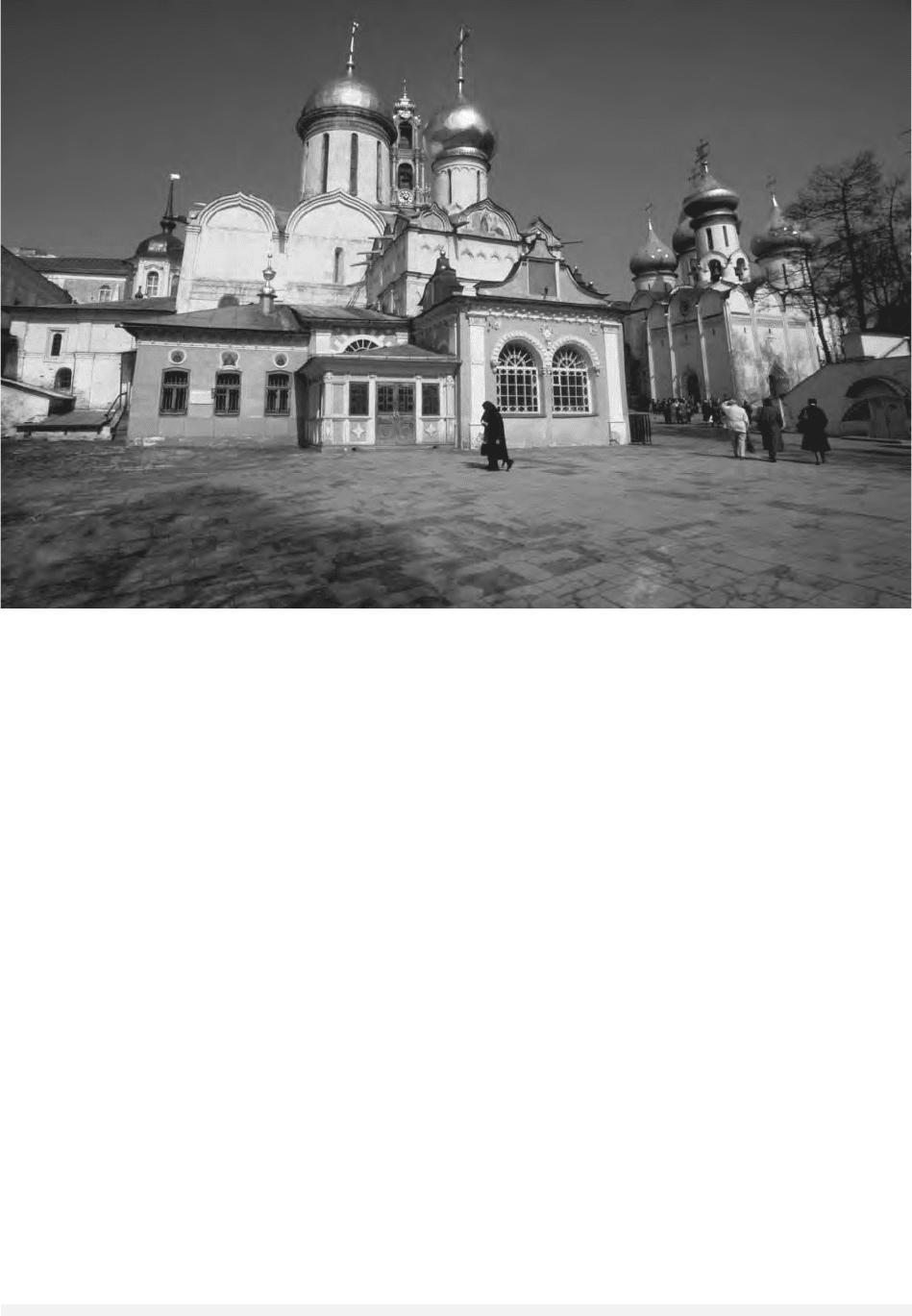
controlled their own property. As of 1561, Trin-
ity’s abbot held the rank of Archimandrite, senior
to the heads of all Russian monasteries. Trinity
again was important in 1682 when child co-tsars
Ivan V and Peter I “the Great” and Ivan’s sister and
regent Sophia hid there until a military revolt was
pacified. In 1689 Peter fled to Trinity from Sophia
and her soldier allies, rallied support, and returned
to Moscow as sole ruler. Neither the Law Code of
1649, nor the religious reforms of rulers Peter I and
Anna I Ivanovna, materially diminished Trinity’s
status. It was designated a lavra in 1744, the high-
est class of monastery, one of four in Russia, and
a seminary was established there. Catherine II “the
Great,” however, ordered that monastic lands and
serfs be turned over to the state in 1764. Trinity
was limited to one hundred monks and a state sub-
sidy. It recovered during the 1800s, aided by a re-
ligious revival and the easing of restrictions on
monastic landholding. In 1814 the Moscow Theo-
logical Academy took residence at Trinity. When
Russia celebrated the five-hundredth anniversary of
Sergius’s death in 1892, the Trinity Monastery had
over four hundred monks and novices and con-
trolled five new monastic communities. After the
Russian Revolution, the Soviets confiscated Trin-
ity’s properties, disinterred Sergius’s remains, dis-
persed its monks, and closed the theological
academy. It became a museum of Russian history
and art. Many of its treasures and most of its
archive were brought to Moscow. In 1946 Stalin
allowed the monastery to reopen and rebury
Sergius’s remains. When Soviet power ended in
1991, Trinity flourished anew as a cult center.
The Trinity Sergius Monastery remains a trea-
sure-house of Russian art and architecture. The
Church of the Trinity (1422–1427) and the Church
of the Holy Spirit with its graceful bell tower
(1486) are the oldest buildings. The ceremonial cen-
ter is the five-domed Cathedral of the Dormition
(1559–1585). The huge refectory with a church of
St. Sergius (1686–1692), the tsars’ palace (c. 1690)
in the Moscow Baroque style, and the five-tiered
bell tower (1740–1770) are also noteworthy. Trin-
ity’s scriptorium and workshops produced impor-
TRINITY ST. SERGIUS MONASTERY
1573
ENCYCLOPEDIA OF RUSSIAN HISTORY
Exterior view of the Trinity St. Sergius Monastery. © D
AVE
B
ARTRUFF
/CORBIS

tant chronicles and religious writings, clothing,
icons, and religious utensils to supplement equally
lavish gifts from its patrons. In 1993 UNESCO rec-
ognized the ensemble as a World Heritage site.
See also: KIRILLO-BELOOZERO MONASTERY; MONASTERIES;
SERGIUS (SAINT); SIMONOV MONASTERY; SOLOVETSK
MONASTERY
BIBLIOGRAPHY
Kenworthy, Scott M. (2002). “The Revival of Monasti-
cism in Modern Russia: The Trinity-Sergius Lavra,
1825–1921,” Ph.D. diss., Brandeis University,
Waltham, MA.
Miller, David B. (1997). “Donors to the Trinity-Sergius
Monastery as a Community of Venerators: Origins,
1360s–1462.” In Kleimola, A. M., and Lenhoff, G.
D., eds., Culture and Identity in Muscovy, 1359–1584.
Moscow: ITZ-Garant.
D
AVID
B. M
ILLER
TROTSKY, LEON DAVIDOVICH
(1879–1940), number-two leader of the Bolshevik
Revolution, and subsequent rival of Stalin.
A prominent left-wing Menshevik after his
leading role in the Revolution of 1905, Leon Trot-
sky (né Lev Bronstein) joined the Bolsheviks in
1917, became Vladimir Lenin’s de facto second in
command during the October Revolution and the
civil war, and then went into opposition until he
was exiled and eventually murdered at Josef
Stalin’s behest.
PREREVOLUTIONARY CAREER
Trotsky was born in the village of Yanovka in what
is now Ukraine on November 7 (October 26, O. S.),
1879. His father was a prosperous farmer of Rus-
sified Jewish background. Young Bronstein was
sent to school in Odessa, where he lived with a rel-
ative who belonged to the intelligentsia, and he be-
gan to display the intellectual brilliance that
marked his entire life. He was attracted to the rev-
olutionary movement and Marxism, helped orga-
nize an illegal workers’ movement, and was
arrested in 1898. He spent four years in prison and
in Siberian exile, but escaped in 1902 (under the
pseudonym Trotsky), leaving behind a wife and
two baby daughters.
Making his way to Western Europe, Trotsky
joined Lenin in publishing the Marxist paper Iskra
(Spark), but at the Second Congress of the Russian
Social-Democratic Party in 1903 he sided with the
Mensheviks and spoke out against Lenin’s author-
itarian concept of the party. Meanwhile he married
Natalia Sedova, by whom he had two sons.
When revolutionary uprisings shook the tsarist
regime in 1905, Trotsky returned to Russia. He
joined the St. Petersburg Soviet of Workers’
Deputies and became its most vocal leader. For this
he was arrested, put on trial, and again sent to
Siberia. In jail he wrote Results and Prospects, set-
ting forth his theory of permanent revolution to
predict that a bourgeois revolution would go on
permanently until it turned into a workers’ revo-
lution in Russia and triggered proletarian revolu-
tion elsewhere.
After escaping from Siberia again in 1907,
Trotsky settled in Vienna to work as a journalist
(notably during the Balkan Wars of 1912–1913)
and to participate in émigré Social-Democratic pol-
itics as a left-wing Menshevik. With that group he
opposed Russian participation in World War I, a
position for which he was expelled from one Eu-
ropean country after another, and he found him-
self in New York when the February Revolution
broke out.
REVOLUTION AND CIVIL WAR
Trotsky welcomed the fall of the tsarist regime as
the beginning of the permanent revolution he had
predicted. Following a brief detention in Canada he
made his way back to Russia in May 1917. There
he took the lead of the left Mensheviks who called
themselves the Interdistrict Group and agreed with
the Bolsheviks on opposing the war and pushing
for a new revolution. Although jailed by the Pro-
visional Government after the abortive July Days
uprising, Trotsky and his group were absorbed into
the Bolshevik Party at the Sixth Party Congress in
August 1917, and Trotsky was elected to the Cen-
tral Committee.
Released from jail after the failed right-wing
putsch by General Lavr Kornilov, and responding
to the upsurge in popular revolutionary sentiment,
Trotsky took the lead in agitating for a revolu-
tionary takeover by the Petrograd Soviets of Work-
ers’ and Soldiers’ Deputies. Yet, like most of the
Bolshevik leaders, he resisted Lenin’s call for an
armed coup prior to the Second Congress of Sovi-
ets that was scheduled for late October 1917. As
TROTSKY, LEON DAVIDOVICH
1574
ENCYCLOPEDIA OF RUSSIAN HISTORY
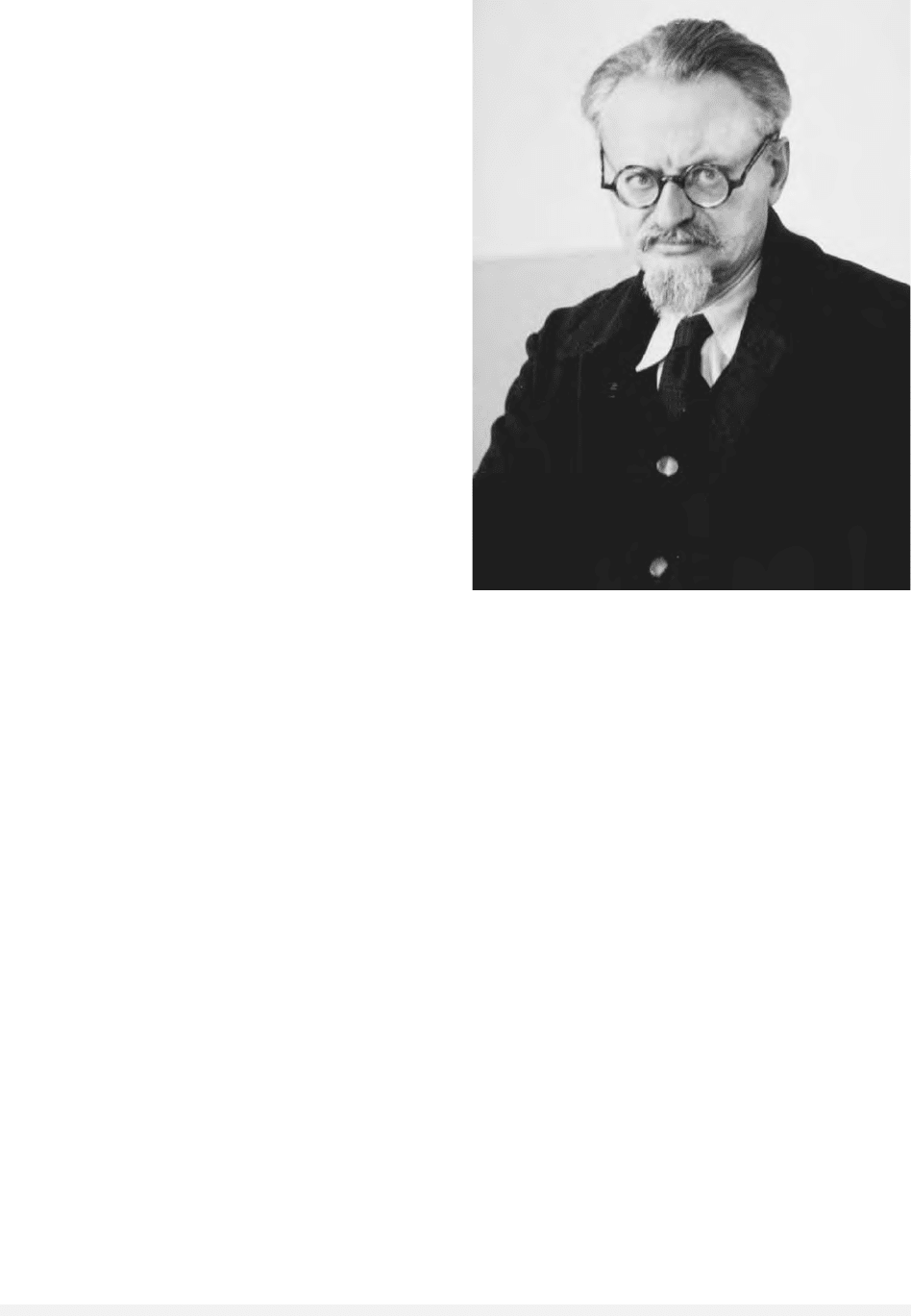
chairman of the Petrograd Soviet from September
on, Trotsky is generally credited with being the or-
ganizer of the October Revolution, though how de-
liberately the Bolshevik takeover was prepared is
debatable. Evidence of a planned uprising is lack-
ing, apart from improvised steps to mobilize pro-
Bolshevik troops and workers’ Red Guards to
defend the Soviet against the Provisional Govern-
ment. When the government attempted a preemp-
tive raid on October 24, Trotsky sent troops and
workers’ Red Guards out to take over the city of
Petrograd; proclaimed the overthrow of the Provi-
sional Government; and presented the Congress of
Soviets with a fait accompli when it convened on
October 25. Subsequently he denied that he had dif-
fered with Lenin about waiting for the Congress of
Soviets, claiming that his statements to that effect
had only been intended to deceive the government.
Immediately after the Bolsheviks’ takeover of
Petrograd and their capture of the Winter Palace,
the Congress of Soviets approved a new Soviet gov-
ernment with Lenin as Chairman of the Council of
People’s Commissars. Trotsky became Commissar
of Foreign Affairs. In the next few days he directed
pro-Bolshevik forces in beating back an attempt by
Alexander Kerensky to regain power, and he sup-
ported Lenin in rejecting a government coalition
with the moderate socialists.
As foreign commissar Trotsky directed diplo-
matic overtures to end the war, and, failing that,
to negotiate a separate peace with the Central Pow-
ers. Repelled by Germany’s demands, he and his
supporters abstained in the crucial 7-4 vote in the
Central Committee to accept the Treaty of Brest-
Litovsk, and he resigned the foreign affairs portfo-
lio in protest. However, he was immediately made
Commissar of War, and in this capacity set about
organizing a new, disciplined Red Army to replace
the old army that had virtually disintegrated. He
rejected the guerrilla tactics favored by many Bol-
sheviks and made the controversial decision to em-
ploy former tsarist officers as military specialists
under the supervision of political commisssars.
When civil war broke out in May 1918, Trotsky
commanded the communist Red forces and turned
back offensives by the counterrevolutionary White
forces that year and the next. He became a mem-
ber of the Communist Party Politburo when it was
created in 1919. Once victory had been won over
the Whites in 1920, Trotsky proposed a military
approach to rebuilding the country’s economy, in-
cluding militarization of labor and absorption of
the trade unions into the state, an approach that
led later commentators to regard him as a precur-
sor of the Stalinist planned economy. However, in
the Trade Union Controversy of 1921, Trotsky and
his friends were defeated by Lenin in the name of
a more moderate policy of state capitalism, pre-
saging the New Economic Policy (NEP). Lenin was
supported by Trotsky’s future rivals Josef Stalin
and Grigory Zinoviev, with whom Trotsky had al-
ready clashed during the civil war. Nevertheless,
Trotsky took charge of suppressing the March
1921 rebellion at the Kronstadt naval base near Pet-
rograd that had been brought on by Communist
abuses.
IN OPPOSITION
Set back at the Tenth Party Congress in March
1921, Trotsky remained Commissar of War during
Lenin’s subsequent illness, while the troika of Stalin,
Zinoviev, and Lev Kamenev maneuvered to keep him
from succeeding Lenin as party leader. In his cele-
brated Testament, Lenin noted Trotsky’s exceptional
abilities, but faulted his too far-reaching self confi-
TROTSKY, LEON DAVIDOVICH
1575
ENCYCLOPEDIA OF RUSSIAN HISTORY
Born Lev Davidovich Bronstein, Leon Trotsky became Stalin’s
principal rival for power. A
RCHIVE
P
HOTOS
. R
EPRODUCED BY
PERMISSION
.
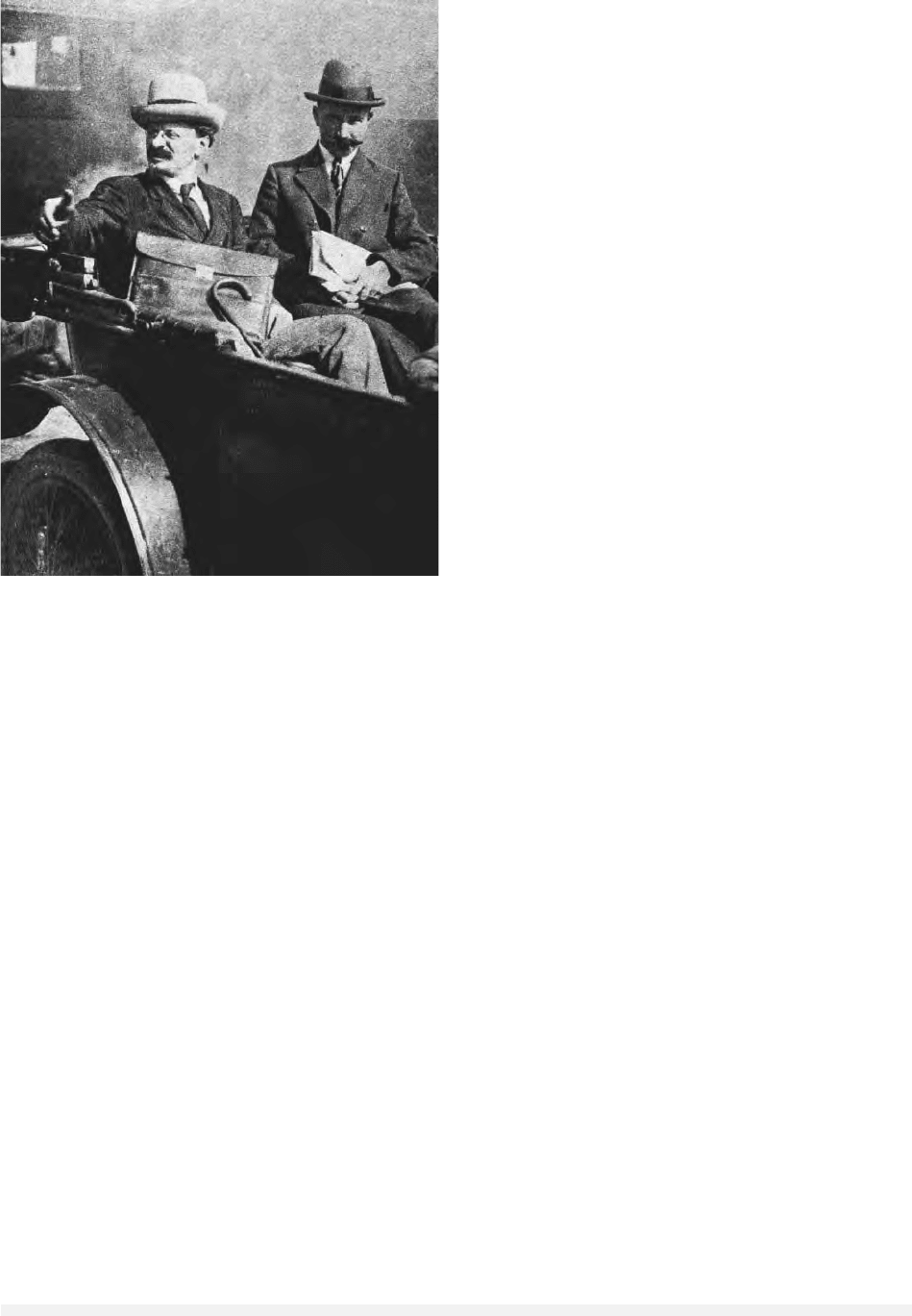
dence. He nevertheless invited Trotsky to lead an at-
tack on Stalin, but Trotsky passed up the opportu-
nity (fearing anti-Semitism, as archives opened in
1990 revealed). Some months later, in October
1923, Trotsky launched a behind-the-scenes attack
on the rest of the communist leadership for violat-
ing democratic procedures within the party. Going
public with a series of articles, “The New Course,”
Trotsky was in turn denounced by his rivals for vi-
olating the party’s rule against factionalism. While
Trotsky fell ill, his supporters were crushed in the
New Course controversy and condemned at the
Thirteenth Party Conference in January 1924 as
a petty-bourgeois Menshevik deviation. Coming
barely a week before Lenin’s death, this was the de-
cisive defeat for Trotsky and his friends, and for po-
litical pluralism within the Communist Party.
Trotsky’s subsequent struggle against Stalin was
futile and anti-climactic.
Denounced again at the Thirteenth Party Con-
gress in May 1924, Trotsky sarcastically affirmed
the infallibility of the party. He took the occasion
of the seventh anniversary of the Bolshevik Revo-
lution to denounce Zinoviev and Kamenev as failed
revolutionary leaders. This act triggered a new out-
burst of official denunciation of Trotskyism and
the theory of permanent revolution as anti-Lenin-
ist heresy. In January 1925 the leadership went
further and removed Trotsky from the Commis-
sariat of War.
When Zinoviev and Kamenev broke with Stalin
later in 1925, Trotsky sat on the sidelines. After
their defeat, he belatedly joined them in the United
Opposition, vainly fighting Stalin in 1926 and
1927 over the issues of party democracy, excessive
concessions to the peasantry, and Stalin’s theory
of “socialism in one country” that downplayed
world revolution. Trotsky was removed from the
Politburo in October 1926 and from the Central
Committee just one year later. After attempting a
demonstration on the tenth anniversary of the rev-
olution in November 1927, he was expelled from
the party. The same fate awaited his followers at
the Fifteenth Party Congress in December, where
not a single voice was heard in defense of the op-
position.
Despite his declining political fortunes, Trot-
sky wrote widely during the mid-1920s, produc-
ing such works as Literature and Revolution and
Problems of Life, along with a series of books on
international politics and a stream of platforms
and polemics that remained unpublished in his
lifetime.
EXILE AND DEATH
In January 1928 Trotsky and many of his fol-
lowers were exiled; many were sent to Siberia and
Central Asia, Trotsky himself to Alma Ata in Kaza-
khstan. There he continued to correspond with his
sympathizers and to criticize Stalin’s new indus-
trialization drive. As a result, in January 1929, he
was deported from the Soviet Union to Turkey,
where he continued to write, completing his auto-
biography and his History of the Russian Revolution.
In 1933 he moved to France, and in 1934 he pro-
claimed the formation of a Fourth International
challenging the legitimacy of the Third Communist
International. In many countries Trotskyist parties
split off from the communists, including the So-
cialist Workers’ Party in the United States and, in
Spain, the POUM (Partido Obrero de Unificación
Marxista), suppressed by Stalinist sympathizers in
the course of the Spanish Civil War.
Expelled from France in 1935, Trotsky moved
to Norway, whence he was expelled under Soviet
TROTSKY, LEON DAVIDOVICH
1576
ENCYCLOPEDIA OF RUSSIAN HISTORY
Leon Trotsky at Brest-Litovsk, 1918. T
HE
A
RT
A
RCHIVE
/M
USÉE DES
2
G
UERRES
M
ONDIALES
P
ARIS
/D
AGLI
O
RTI

pressure in 1936. He then settled in Mexico, in the
town of Coyoacán, where he lived until his assas-
sination in 1940. Trotsky was virtually expunged
from official Soviet history, becoming an “unper-
son” in George Orwell’s term; writings by or about
him were completely suppressed. During the
Moscow Trials of 1936–1938 he was vilified in ab-
sentia as a counterrevolutionary traitor, a charge
of which he was absolved by an American investi-
gating committee headed by the philosopher John
Dewey. Trotsky fired back in numerous writings,
notably The Revolution Betrayed, charging that
Stalin’s regime was a bureaucratic perversion of so-
cialism and calling quixotically for a new workers’
revolution.
Trotsky was murdered on August 20, 1940,
by an undercover agent of the Soviet secret police,
a Spanish communist named Ramón Mercader,
who had gained entry to the victim’s household
under a pseudonym. The Soviet government denied
involvement, though its role has since been well es-
tablished. Mercader served a twenty-year prison
sentence. Trotsky continued to be demonized in the
Soviet Union, and the Gorbachev government never
got around to rehabilitating him officially as it did
other purge victims. His personal archive has been
preserved at Harvard University.
Trotsky was a brilliant writer and a charismatic
revolutionary leader. As a politician, however, he
was by all accounts arrogant and arbitrary, and he
antagonized most of his communist associates in
the years when personal opinions still counted. His
military methods during the civil war are often re-
garded as an anticipation of Stalinism, though in
later years he protested the violation of democratic
procedures and the growth of bureaucratic privilege
in the Soviet Union. He is often viewed as an apos-
tle of world revolution, in contrast with Stalin’s na-
tionalism. In any case, Stalin became obsessed with
destroying Trotsky and anyone connected with
him, including family members.
See also: BOLSHEVISM; LENIN, VLADIMIR ILICH; MENSHE-
VIKS; PERMANENT REVOLUTION; STALIN, JOSEF VIS-
SARIONOVICH
BIBLIOGRAPHY
Breitman, George, and Reed, Evelyn, eds. (1969–) Writ-
ings of Leon Trotsky. 14 vols. New York.
Brotherstone, Terry, and Dukes, Paul, eds. (1992). The
Trotsky Reappraisal. Edinburgh: Edinburgh Univer-
sity Press.
The Case of Leon Trotsky: Report of Hearings on the Charges
Made against Him in the Moscow Trials. (1937). New
York.
Daniels, Robert V. (1960). The Conscience of the Revolu-
tion: Communist Opposition in Soviet Russia. Cam-
bridge, MA: Harvard University Press.
Daniels, Robert V. (1991). Trotsky, Stalin, and Socialism.
Boulder, CO: Westview Press.
Deutscher, Isaac. (1954). The Prophet Armed: Trotsky,
1879–1921. London: Oxford University Press.
Deutscher, Isaac. (1959). The Prophet Unarmed: Trotsky,
1921–1929. London: Oxford University Press.
Deutscher, Isaac. (1963). The Prophet Outcast: Trotsky,
1929–1940. London: Oxford University Press.
Howe, Irving. (1978). Leon Trotsky. New York: Viking
Press.
Knei-Paz, Baruch. (1978). The Social and Political Thought
of Leon Trotsky. Oxford: Oxford University Press.
Molyneux, John. (1981). Leon Trotsky’s Theory of Revolu-
tion. New York: St. Martin’s Press.
Trotsky, Leon. (1930). My Life: An Attempt at an Autobi-
ography. New York: Scribners.
Trotsky, Leon. (1975). The Challenge of the Left Opposi-
tion (1923–1925), ed. Naomi Allen. New York:
Pathfinder Press.
Volkogonov, Dmitri A. (1996). Trotsky: The Eternal Rev-
olutionary. New York: Free Press.
Wolfe, Bertram D. (1948). Three Who Made a Revolution:
A Biographical History. New York: Dial Press.
Wolfenstein, E. Victor. (1967). The Revolutionary Person-
ality: Lenin, Trotsky, Gandhi. Princeton, NJ: Prince-
ton University Press.
R
OBERT
V. D
ANIELS
TRUDODEN See LABOR DAY.
TRUMAN DOCTRINE See COLD WAR.
TRUSTS, SOVIET
At the behest of Vladimir Lenin, war communism,
which was introduced during the civil war and
sought to achieve full state ownership and opera-
tion of the economy immediately, was abandoned
as unwieldy, unworkable, and premature. It was
replaced by the NEP, under which state industry
TRUSTS, SOVIET
1577
ENCYCLOPEDIA OF RUSSIAN HISTORY

was divided into two categories: the commanding
heights and a decentralized sector. The former in-
dustries, which included fuel, metallurgy, the war
industries, transportation, banking, and foreign
trade, remained under direct supervision of the gov-
ernment in the form of the Supreme Council of the
National Economy (VSNKh). These industries con-
tinued as part of the central budget and were sub-
ject to centralized allocations of supplies and outputs.
The decentralized industries, consisting mainly
of firms serving ordinary consumers, were en-
couraged to form into trusts. VSNKh created six-
teen new departments, which replaced the fifty or
so glavki, to supervise the largest and most im-
portant trusts. About a quarter of the trusts,
mainly involved in light industry, were supervised
at the decentralized level of the sovnarkhozy. By
mid-1923 there were 478 trusts composed of 3,561
enterprises and employing about 75 percent of the
total industrial workforce. Subsequently, many
trusts were amalgamated into even larger units,
known as syndicates.
The consolidation of industries into trusts and
of trusts into syndicates was obviously intended to
make control and coordination of the economy
simpler and more effective. These large-scale orga-
nizations posed certain problems, especially when
their managers sought to use the monopoly power
they provided against consumers or other sectors
of the economy. The Soviet trust disappeared with
the beginning of rapid industrialization and the
five-year plan era of the 1930s.
See also: COMMITTEE FOR THE MANAGEMENT OF THE NA-
TIONAL ECONOMY; NEW ECONOMIC POLICY
BIBLIOGRAPHY
Maurice Dobb. (1948). Soviet Economic Development since
1917. New York: International Publishers.
Gregory, Paul R., and Robert C. Stuart, Soviet Economic
Structure and Performance, 4th ed. New York: Harper-
Collins.
J
AMES
R. M
ILLAR
TSARSKOYE SELO
Tsarskoye Selo (known as Detskoye Selo between
1918 and 1937, Pushkin thereafter) is a suburb of
St. Petersburg best known for its imperial palaces
and its lyceum. The town was established in 1708
on the site of a conquered Finnish village, not long
after the founding of St. Petersburg. The first rail-
road in Russia, opened in 1837, connected Tsarskoye
Selo to the capital, about twenty-five kilometers
(fourteen miles) away. In 1887 Tsarskoye Selo also
became the first European town to be illuminated
by electricity.
Tsarskoye Selo (literally “the Tsar’s Village”)
was among the residences of the imperial family
from the time of its founding until 1917. Celebrated
as the Russian Versailles, the town’s layout and cul-
ture owed much to the admiration that the Em-
peror Peter the Great and his successors felt for the
French original and other European models. Ini-
tially, between 1708 and 1724, Tsarskoye Selo
served as the residence of Peter’s wife, the Empress
Catherine I. The original Catherine Palace, named
after her, was constructed at that time. Substantial
rebuilding of the complex was undertaken during
the reign of the Empress Elizabeth (1741–1762),
with many famed architects and artists taking part
in the project. The most famous example is the ar-
chitect Francesco Bartolomeo Rastrelli’s work on the
imperial palace. It is acknowledged as a masterpiece
of Russian baroque. The stucco decorations of the
facade of the immense palace were gilded so lav-
ishly that, according to contemporaries, in sunlight
one could not bear to look at the building directly.
To correct this defect and reduce maintenance costs,
the gilding was soon replaced by ochre paint. The
contrast between the azure paint of the walls and
the ochre color of the decorations continues to de-
fine the palace’s look. Further notable changes and
additions were made during the reign of Empress
Catherine II (1762–1796). Among them was the
construction of the classicist Alexander Palace, com-
missioned by the empress to honor her favorite
grandson and future monarch, Alexander I. Aside
from the elaborate palaces decorated with impres-
sive art works, Tsarskoye Selo also featured lavish
parks and the quarters for various regiments of the
imperial guard. In the words of the poet Nikolai Gu-
milev, “barracks, parks, and palaces” defined the ap-
pearance of the town.
Numerous grand dukes lived in Tsarskoye Selo
throughout its existence, but the town gained
greater official stature after 1905, when Nicholas
II made it his permanent residence. It was in
Tsarskoye Selo that the last emperor of Russia was
arrested by the Provisional Government during the
February Revolution of 1917, and it was from there
that he was exiled with his family to Siberia in July
of that year.
TSARSKOYE SELO
1578
ENCYCLOPEDIA OF RUSSIAN HISTORY
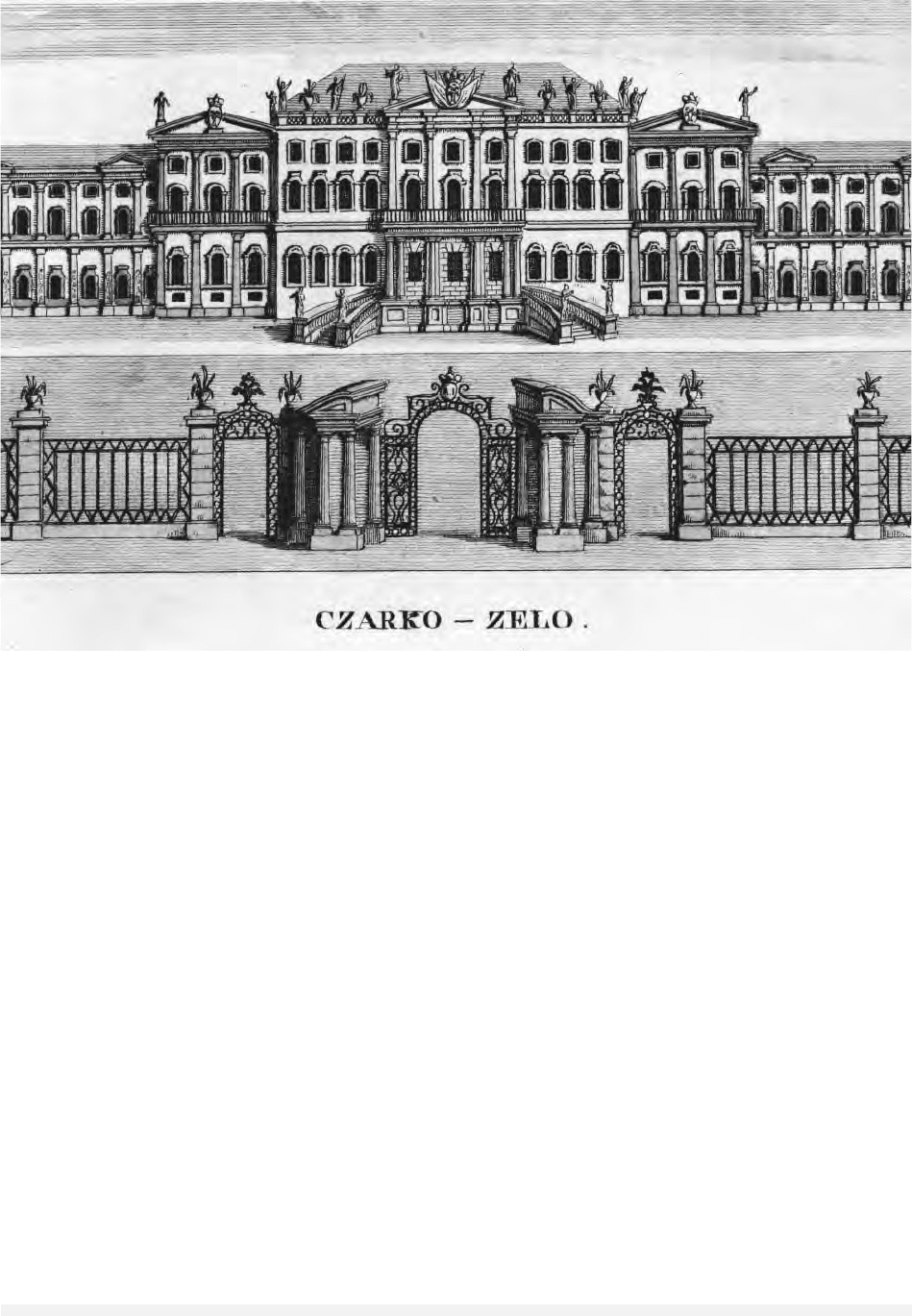
The Lyceum, a school for the offspring of the
nobility, opened in Tsarskoye Selo in 1811. The
stated mission of this prestigious school was to train
young men for service to the state. Between 1817
and 1895 the Lyceum produced fifty-one classes,
shaping the crème de la crème of the empire’s po-
litical and cultural elite. The most famous graduate
was the poet Alexander Pushkin, whose poetry fea-
tured repeated allusions to his alma mater and im-
mortalized Tsarskoye Selo as a literary image.
Among the numerous other prominent alumni
were literary figures Anton Delvig, Lev Mei, and
Mikhail Saltykov-Shchedrin; scholars Grigory
Danilevsky, Yakov Grot, and Alexander Veselovsky;
Decembrists Wilhelm Küchelbecker and Ivan
Pushchin; and counselor Alexander Gorchakov.
At the beginning of the twentieth century, the
poets Anna Akhmatova, Gumilev, and Innokenty
Annensky made Tsarskoye Selo their home. Nu-
merous painters, attracted by the allure of the
Russian Versailles, were also drawn to the town.
Among them were Alexandre Benois, Mstislav
Dobozhinsky, Alexander Golovin, Yevgeny Lansere,
and Konstantin Somov.
During the Soviet period, Tsarskoye Selo was
the subject of both passive neglect and active de-
struction. The town’s central church (St. Cather-
ine’s Cathedral, erected in 1840, designed by
Konstantin Ton) was detonated in 1939. A large
statue of Lenin, erected in 1960, still stands in its
place. During World War II, the town was cap-
tured and looted by the Nazis. Much of its artistic
heritage was destroyed and only partially recon-
structed in the postwar period. Despite all this,
Tsarskoye Selo remains an important tourist des-
tination. Retaining an aristocratic aura, the town
constitutes a cultural preserve of literary and artis-
tic traditions.
TSARSKOYE SELO
1579
ENCYCLOPEDIA OF RUSSIAN HISTORY
View of the Catherine Palace at Tsarkoye Selo, from an 1807 publication by Georg Reinbeck in which he describes his 1805 travels
from St. Petersburg through Moscow and other Eastern European destinations to Germany in a series of letters. T
HE
A
RT
A
RCHIVE
/B
IBLIOTECA
N
AZIONALE
M
ARCIANA
V
ENICE
/D
AGLI
O
RTI
(A)

See also: ARCHITECTURE; NICHOLAS II; PUSHKIN, ALEXAN-
DER SERGEYEVICH
BIBLIOGRAPHY
Kurth, Peter. (1995). Tsar: The Lost World of Nicholas and
Alexandra. Boston: Little, Brown.
Wortman, Richard S. (1995). Scenarios of Power: Myth and
Ceremony in Russian Monarchy, Vol. 1: From Peter the
Great to the Death of Nicholas I. Princeton, NJ: Prince-
ton University Press.
A
NNA
P
ETROVA
I
LYA
V
INKOVETSKY
TSAR, TSARINA
The term tsar and its variants derive from the Latin
word caesar, or emperor. During the fifteenth cen-
tury, Muscovite grand prince Ivan III began using
the term to introduce an added level power and
majesty to his rule. In 1547 his son, sixteen-year
old prince Ivan IV, crowned himself tsar of all Rus-
sia. Indicating the increased significance of Ortho-
doxy, Ivan adopted other conventions from the
Byzantine Empire at the same time, including a va-
riety of court rituals and the double-headed eagle
emblem. The eagle signified the uniting of eastern
and western Christianity through Ivan III’s mar-
riage to Sophia Paleologue, a niece of the last
Byzantine emperor, Constantine XI.
Russian leaders continued to be tsars until
1721, when Peter the Great styled himself as “Em-
peror of All Russia.” Peter chose the more Western
style because he wanted to reflect Russia’s obser-
vance of the rule of law and entry into the Age of
Reason. However, the term tsar remained in com-
mon usage to designate the Russian ruler.
Tsar is used for the male sovereign; his consort
is the tsarina. In the event of a female sovereign,
such as Catherine the Great, she is crowned tsar-
itsa. The heir to the throne is designated the tsare-
vich a word derived from tsar plus the male
patronymic suffix “evich.”
The term itself has outlived the Russian monar-
chy. Russian leaders who exhibit autocratic ten-
dencies, most notably Boris Yeltsin, have been
derided or lampooned as tsars (e.g., Tsar Boris).
Even in the United States, individuals with consid-
erable personal authority have been dubbed tsar.
For example, the leader of U.S. drug policy was in-
formally known as the drug tsar.
See also: AUTOCRACY
BIBLIOGRAPHY
Iskenderov, A. A., and Raleigh, Donald J., eds. (1996).
The Emperors and Empresses of Russia: Rediscovering
the Romanovs. Armonk, NY: M. E. Sharpe.
Lincoln, W. Bruce. (1981). The Romanovs: Autocrats of All
the Russias. New York: Dial Press.
A
NN
E. R
OBERTSON
TSIOLKOVSKY, KONSTANTIN
EDUARDOVICH
(1857–1935), Russian space technology expert.
Born in Izhevskoye, Tsiolkovsky was a pioneer
of rocket technology and astronautics, known in
Russia as cosmonautics. Tsiolkovsky might be
termed the “Robert Goddard of Russia,” after the
American rocket expert, who, like Tsiolkovsky, be-
gan testing rockets in the first decade of the twen-
tieth century.
Tsiolkovsky is generally credited with deduc-
ing for the first time the laws of motion of a rocket
as a body of a variable mass in space without grav-
ity. This, in turn, demonstrated the possibility of
using rockets for interplanetary exploration. He
also investigated the effect of air drag on rocket
motion. Such theories and research became subjects
of his writings, which included Space Rocket Trains,
published in 1929, which explored the theory of
multistage rockets.
Among Tsiolkovsky’s major influences on fu-
ture space flight, and in particular on the success-
ful orbiting of the world’s first sputnik (in October
1957), was his work on liquid-propellant engines.
In such research and writing he developed the spec-
ifications for rocket-engine design. Modern rocket
engines still incorporate many of his basic ideas.
Much attention is given in Tsiolkovsky’s writ-
ings to problems of organizing interplanetary travel
and its prospects. He argued that beginning with
artificial earth satellites (sputniks), interplanetary
stations and flights to the planets could become a
way of establishing communities in outer space and
adapting space for human needs.
With the advent of Soviet power in Russia, Tsi-
olkovsky’s work received the full support of the
state. In 1918 he was elected to the Socialist Acad-
emy of Science. Later honors included membership
TSAR, TSARINA
1580
ENCYCLOPEDIA OF RUSSIAN HISTORY

in Russia’s main cosmonautics society and the
Zhukovsky Air Force Academy. His collected sci-
entific writings appeared in the USSR from 1951
through 1964.
See also: ACADEMY OF SCIENCES; SPACE PROGRAM
BIBLIOGRAPHY
Petrovich, G. V. (2002). The Soviet Encyclopedia of Space
Flight. Seattle, WA: University Press of the Pacific.
A
LBERT
L. W
EEKS
TSSU See CENTRAL STATISTICAL AGENCY.
TSUSHIMA, BATTLE OF
In the early twentieth century Russia expanded its
economic and military presence in the Far East, in-
spired by Minister of Finance Sergei Witte and Rus-
sian nationalists close to Nicholas II. Three events
were interpreted by Japan as a direct assault on its
own continental expansion: the construction of the
Trans-Siberian Railroad, begun in 1892; its subse-
quent shortcut, the Chinese Eastern Railway, built
across Manchuria at the turn of the century; and
the Russian acquisition of Port Arthur to
the south as a naval base. After diplomatic efforts
yielded little satisfaction, the modern Japanese
navy suddenly struck at the two major Russian
bases, Vladivostok and Port Arthur, in February of
1904. By this action they destroyed most of the
Russian Far Eastern fleet, and blockaded what re-
mained of it. Russia fared badly in the ensuing
Russo-Japanese War on land, because of poor lead-
ership and geography, and because of the domes-
tic unrest that resulted in the Revolution of 1905.
Belatedly, and as a classic example of poor plan-
ning, Russia dispatched the much larger Baltic fleet,
under the command of Admiral Rozhdestvenski, to
sail around Africa to the Pacific with the goal of
regaining naval dominance in its Far Eastern wa-
ters. Large, unwieldy, and exhausted after the long
voyage, the Russian fleet entered the Straits of
Tsushima (between Japan and Korea) on its way
to Vladivostok in May 1905. The new, modern
Japanese navy, under the command of Admiral
Togo, was waiting for it. The result was one of the
worst disasters in naval history, with most of the
Russian ships quickly sunk or immobilized, and
with little loss on the other side. Only a few Rus-
sian ships, including the cruiser Aurora, of 1917
revolutionary fame, managing to escape.
The consequences of this defeat were enor-
mous. The battle signaled the end of the war and
a search for peace, negotiated through the arbitra-
tion of President Theodore Roosevelt at Portsmouth,
New Hampshire. The loss was a major blow to
Russian military prestige, lowering morale espe-
cially in the navy. Moreover, it prepared the back-
ground for the June 1905 mutiny of the battleship
Potemkin when it was rumored to be among the
next ships to be sent to the Pacific. The defeat also
fomented antigovernment agitation that crystal-
lized in the October Uprising and the Moscow Up-
rising in November. The navy, often referred to,
subsequently, as the Tsushima department, never
recovered, and was prone to radical revolutionary
activism in 1917.
See also: POTEMKIN MUTINY
BIBLIOGRAPHY
Hough, Richard. (1958). The Fleet that Had to Die. Lon-
don: H. Hamilton.
Pleshakov, Konstantin. (2002). The Tsar’s Last Armada:
The Epic Journey to the Battle of Tsushima. New York:
Basic Books.
N
ORMAN
E. S
AUL
TSVETAEVA, MARINA IVANOVNA
(1892–1941), twentieth–century poet, playwright,
translator, and essayist.
Marina Tsvetaeva, one of the most original and
complex poets of the twentieth century, led a life
of fierce passion, material hardship, and ostracism.
Her “poetry of whirling and staccato rhythms”
(Obolensky, 1965) stands outside the trends of her
time, though it shares some of the mysticism of
the Symbolists, the bold experimentation of the Fu-
turists, and the directness of the Acmeists.
Tsvetaeva was born in Moscow. Her father was
a professor of art history; her mother, a talented
but frustrated pianist who wanted Marina to fol-
low in her footsteps. Tsvetaeva began writing verse
at age six. In 1902 the family moved to Europe to
TSVETAEVA, MARINA IVANOVNA
1581
ENCYCLOPEDIA OF RUSSIAN HISTORY
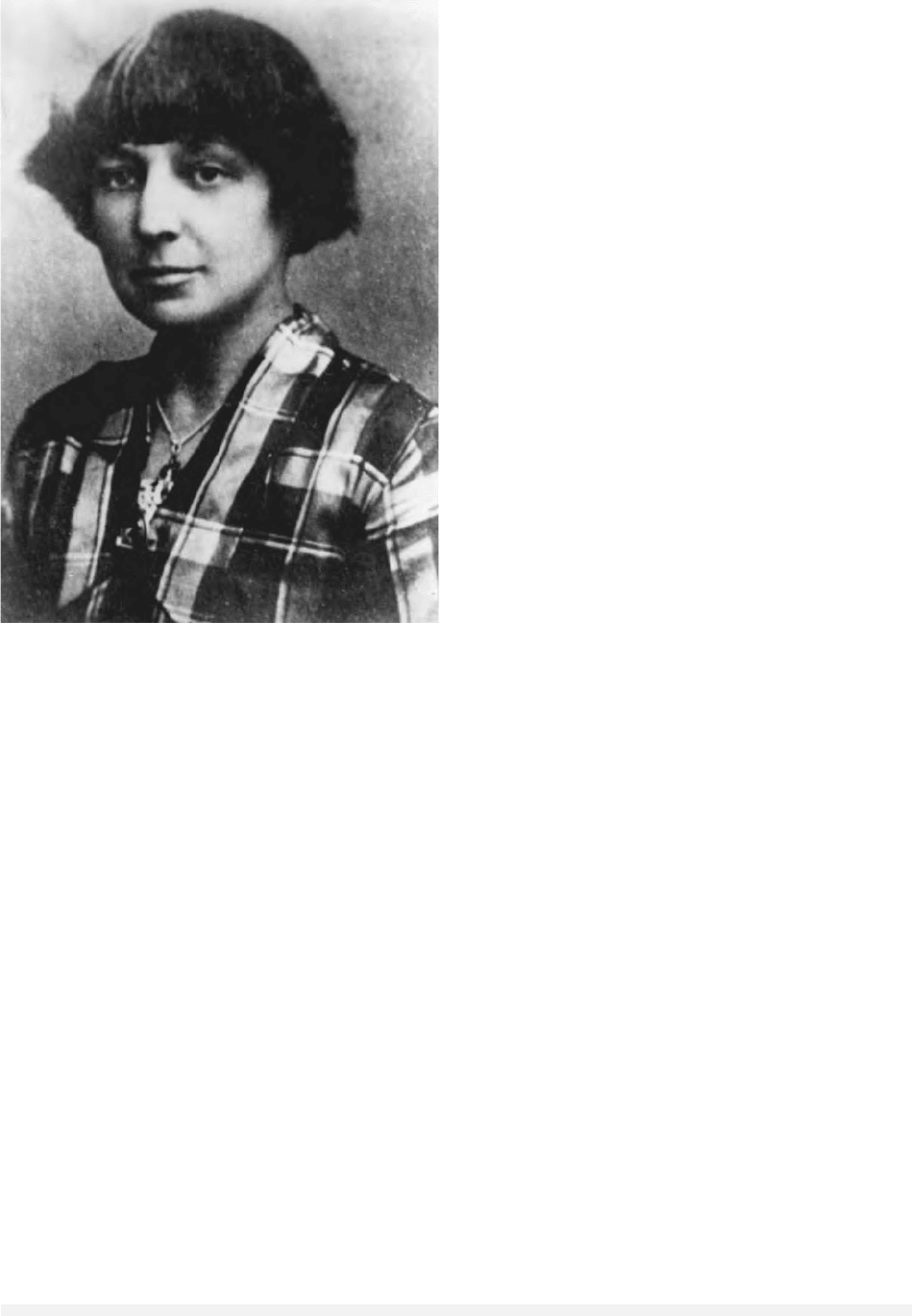
seek tuberculosis treatment for Tsvetaeva’s mother.
They returned to Russia in 1905 and settled in Yalta
(Crimea), where Tsvetaeva’s mother died in 1906.
At age eighteen Tsvetaeva wrote her first collection
of poems, Evening Album (Vecherny albom), which
drew praise from critics such as Valery Bryusov
and Maximilian Voloshin.
In 1912 Tsvetaeva married Sergei Efron and
bore her first child, Ariadna (Alya). Her second
collection, Magic Lantern (Volshebny fonar), and a
collection of her early poetry, From Two Books (Iz
dvukh knig), received lukewarm response. In her
next collection, Juvenilia (Yunosheskie stikhi)-not
published during her lifetime-she embarked on new
forms and treated unconventional themes, includ-
ing her affair with Sophia Parnok, a literary critic
and lesbian. (Tsvetaeva’s affairs and passionate
friendships played a key role in her poetry, as did
her feverish devotion to her husband.) Juvenilia was
followed by Mileposts I (Versty I), which celebrates
her complex friendship with poet Osip Mandelsh-
tam and abounds with innovation.
Tsvetaeva rejected the Russian Revolution, but
her views would prove complex over time: She
would come into conflict with reactionary émigré
circles. At the onset of the Russian civil war, Efron
joined the White Army and lost contact with the
family. Tsvetaeva and her daughters spent five
years of poverty in Moscow. Tsvetaeva sent her
younger daughter, Irina, to an orphanage, only to
learn later that she had died there. Tsvetaeva’s col-
lection Demesne of the Swans (Lebediny stan), un-
published until 1957, expresses support for the
White Army. Other work during this period in-
cludes the collections Mileposts II (Versty II) and
Remeslo (Craft).
In 1922 Tsvetaeva and Alya emigrated to join
Efron, who was in exile. They lived in Berlin, then
Prague, then Paris. She gave birth to her son Georgy
(Moor) in 1925. Her creative output during this pe-
riod includes the poetry collections After Russia
(Posle Rossii) and Verses to My Son (Stikhi k synu)
and the plays Ariadne and Phaedra. Alienated from
both her homeland and the Parisian émigré circles,
Tsvetaeva suffered extreme isolation.
Efron’s political sympathies shifted, and he be-
came a spy for the Soviet Union. Alya, who shared
his views, returned to the Soviet Union in 1937;
Efron followed later that year. Tsvetaeva and her
son joined them in 1939. Boris Pasternak helped
her find translation work, but she was otherwise
ostracized by the government and by established
poets. In 1941 Efron was shot and Alya sent to a
labor camp. Tsvetaeva and her son were evacuated
to Yelabuga (Tatar Republic), where they lacked
means of support. Tsvetaeva committed suicide on
August 31, 1941.
See also: GULAG
BIBLIOGRAPHY
Feinstein, Elaine. (1987). A Captive Lion: The Life of Ma-
rina Tsvetaeva. London: Hutchinson.
Karlinsky, Simon. (1985). Marina Tsvetaeva: The Woman,
Her World, and Her Poetry. Cambridge, UK: Cam-
bridge University Press.
Obolensky, Dimitri. (1976). The Heritage of Russian Verse.
Bloomington: Indiana University Press.
Tsvetaeva, Marina. (1993). Selected Poems, 4th ed., trans.
and intro. Elaine Feinstein. Oxford, UK: Oxford Uni-
versity Press.
D
IANA
S
ENECHAL
TSVETAEVA, MARINA IVANOVNA
1582
ENCYCLOPEDIA OF RUSSIAN HISTORY
Poet Marina Tsvetaeva lived in Switzerland, Germany, Prague,
and France before returning to Russia. © SOVFOTO
